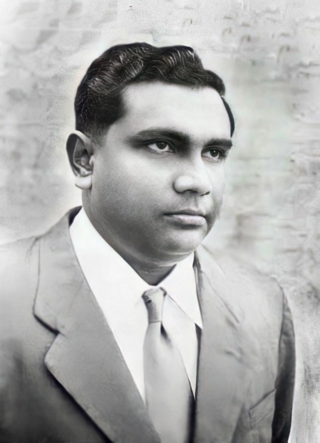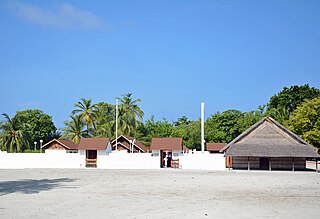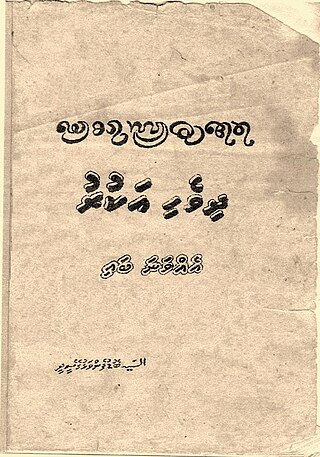Related Research Articles
Thaana, Tãnaa, Taana or Tāna is the present writing system of the Maldivian language spoken in the Maldives. Thaana has characteristics of both an abugida and a true alphabet, with consonants derived from indigenous and Arabic numerals, and vowels derived from the vowel diacritics of the Arabic abjad. Maldivian orthography in Thaana is largely phonemic.

Al Ameer Ibrahim Nasir Rannabandeyri Kilegefan, KCMG, NGIV commonly known as Ibrahim Nasir, was a Maldivian politician adhering to the non-aligned ideology and staunch anti-imperialist. Nasir served as the Prime Minister of the Maldives from 1957 to 1968 under the monarchy, and later the first President of the Second Republic of Maldives from 1968 to 1978. Nasir served two terms, then he decided to retire, even though the People's Majlis voted him in for a third term. Nasir is remembered as an independence hero for guiding the Maldives to independence from the British Empire, he is also credited for establishing the tourism industry in the Maldives, as well as rapidly modernizing and developing the country and economy.

Sultan Muhammad Shamsuddeen Iskander III,, , son of Ibrahim Nooraddeen and Kakaage Don Goma, was the Sultan of the Maldives first from 7 May 1893 and then again from 1902.

Kaashidhoo is one of the inhabited islands of Kaafu Atoll.

Utheemu is one of the inhabited islands of Haa Alif Atoll administrative division and geographically part of Thiladhummathi Atoll in the north of the Maldives. It is an island-level administrative constituency governed by the Utheemu Island Council.

Hussain Salahuddin, was an influential Maldivian writer, poet, essayist and scholar.
Muhammed Ghiya'as ud-din, the son of Sultan Ibrahim Iskandar II, was the sultan of the Maldives from 1766 to 1773. As per the will of his predecessor Dhon Bandaarain, Muhammed Manifufaanu ascended the throne and reigned as Sultan Al-Haj Muhammed Ghiya'as ud-din Iskandar Sri Kula Sundara Maha Radun. He was the last sultan of the Dhiyamigili Dynasty; he was deposed while away on a pilgrimage, and later, on his return trip he drowned, or was murdered by Kalhu Bandaarain.
Several Dhivehi scripts have been used by Maldivians during their history. The early Dhivehi scripts fell into the abugida category, while the more recent Thaana has characteristics of both an abugida and a true alphabet. An ancient form of Nagari script, as well as the Arabic and Devanagari scripts, have also been extensively used in the Maldives, but with a more restricted function. Latin was official only during a very brief period of the Islands' history.
Abdulla, was crown prince of Dhiyamigili dynasty and the Maldives as the son of Sultan Muhammad Ghiyasuddin I of the Dhiyamigili dynasty.

Haddhunmathi or LaamuAtoll is an administrative division of the Maldives. The administrative capital is Fonadhoo Island. It corresponds to the natural atoll of the same name. It is mostly rimmed by barrier reefs, the broadest of which are topped by islands. There are many islands along its eastern and southern boundaries. This atoll is quite regular excepting for the projection of the reef at its NE corner. It closely resembles Kolhumadulhu, its neighbour further north. Owing to its typical atoll shape, it differs in no respect from atolls in the Pacific Ocean, save for its greater size. Its reefs are generally of little breadth, with no signs of vilu, except for its eastern fringes which are covered with islands that are quite large by Maldivian standards. The lagoon is comparatively open, containing scattered shoal patches; the bottom is muddy and the average depth is from 30 to 34 fathoms.
Dhivehi Latin or Maldivian Latin, known colloquially as Malé Latin or Nasiri Latin, is a Latin Maldivian alphabet briefly mandated in the Maldives from 1976, but the country reverted to the native Thaana and Arabic alphabets in 1978. Maldivian Latin is still widely used in non-academic literature for romanizing Maldivian, however its rules are not strictly adhered to by most Maldivians.
Sultan Mohammed Imaduddin I (1580–1648) was the Sultan of Maldives from 11 December 1628 to 1648. He was the son of Umar Maafai Kilage and Mariyam Kabaidhi Kilage. After ruling for 20 years, the sultan died at the age of 68 and was buried in the Koilu Mosque.
Sultan Ibrahim Iskandhar Siri kularanmeeba Kathiri Bavana Mahaa Radun was the sultan of Maldives from 1648 to 1687. He was the son of HH Sultan Muhammad Imaduddin I and Kabaa Aisha. Iskandar ascended to the throne of Maldives at age 18, after the death of his father. During his reign, he rebuilt the Malé Hukuru Miskiy in Malé and began educating his people by teaching the Qur'an. Iskandar died in 1687 after ruling nearly for 40 years. He was succeeded by his son Kuda Muhammad under the regency of his consort Mariyam Kaba'afa'anu Rani Kilege.

Bodufenvalhugey Sidi or Assayyidhu Bodufenvalhugey Seedhee (1888-1970), was a Maldivian intellectual and writer.
Amina I of the Maldives also called Amina Kabafaanu and Aminath Kabafan, was sultana regnant of the Maldives from 1753 until 1754. She also served as joint regent with her spouse Ali Shah Bandar Vela’ana’a Manikufa’anu in 1773 during the pilgrimage of her brother Sultan Muhammed Ghiya'as ud-din to Mecca.
Burecca of the Maldives or Buraki Rani, was a queen consort of the Maldives. She crowned her spouse Kalu Mohamed as king. She herself took the title rani instead of the title Rehendi or sultana, which was normally worn by female monarchs, signifying that she was queen consort rather than a monarch and ruler herself.

Fauziyya Hassan was a Maldivian film actress. She made her film debut in Sidha in 1985. In 1994 she was arrested by the Indian police on espionage charges relating to the Indian Space Research Organisation. She and a friend were accused of passing sensitive defence information to Pakistan. The espionage case against Hassan was not proven and eventually other charges were dropped, though she spent three years in prison under the National Security Act.
Mohamed Afrah Hassan, commonly known as Mohamed Afrah was a Maldivian film actor and producer.
The Family of Iskander ll was a Maldivian Family. It is the family of Iskander ll of the Maldives and His Ancestors. The family is an origin Family of Dhiyamigili dynasty and Malé. The family was formed around 400 years ago by Muhammed Dhorhimeyna thakurufaan, who is the Great Great Grandfather of sultan Iskander ll of the Maldives. The family is also connected to Huraa dynasty, through Iskander ll's great-granddaughter Princess Aisha Rani Kilegefan, she is also known as kakaagey Kalhu Goma,.
References
- Harry Charles Purvis Bell: Excerpta Máldiviana